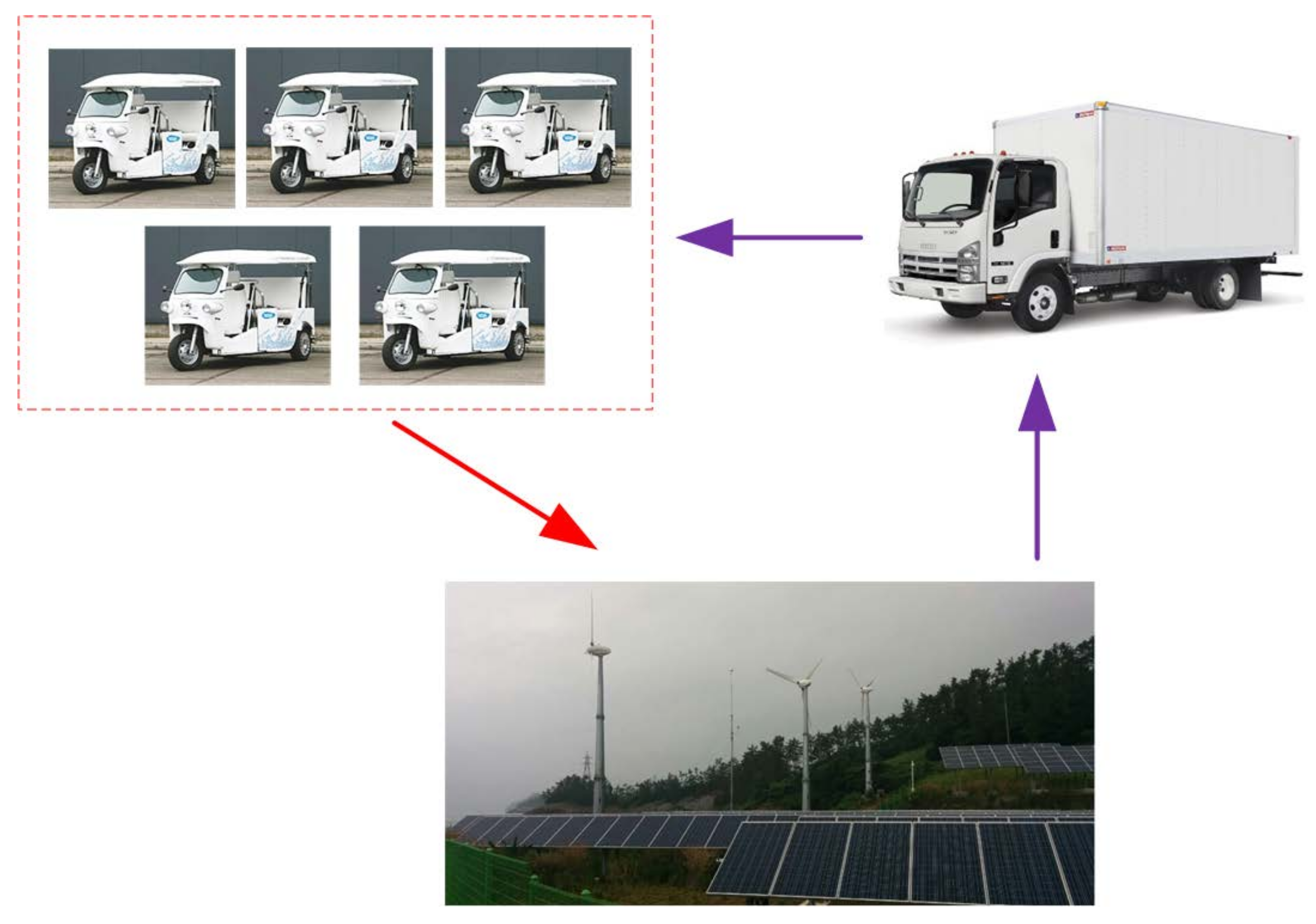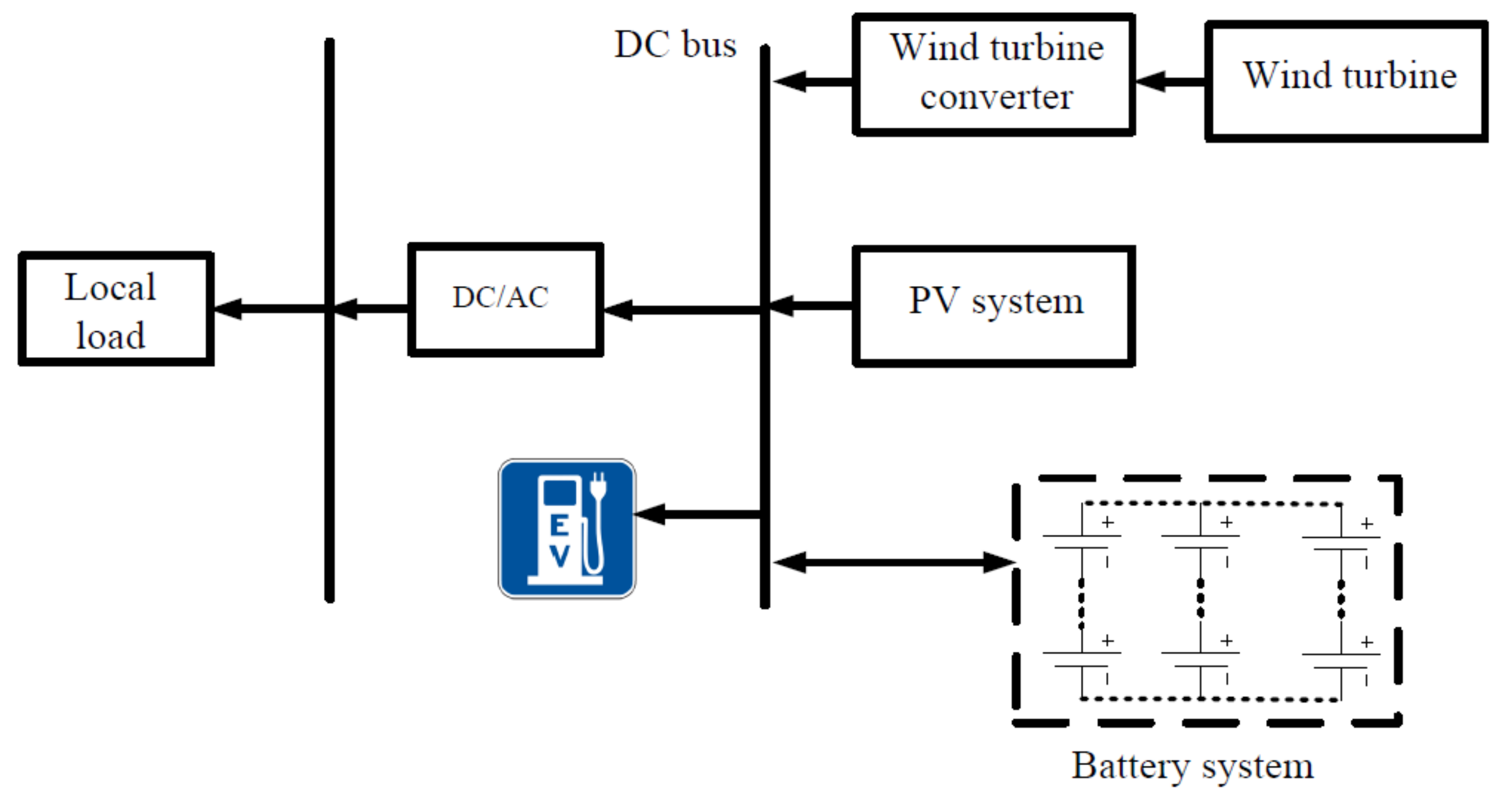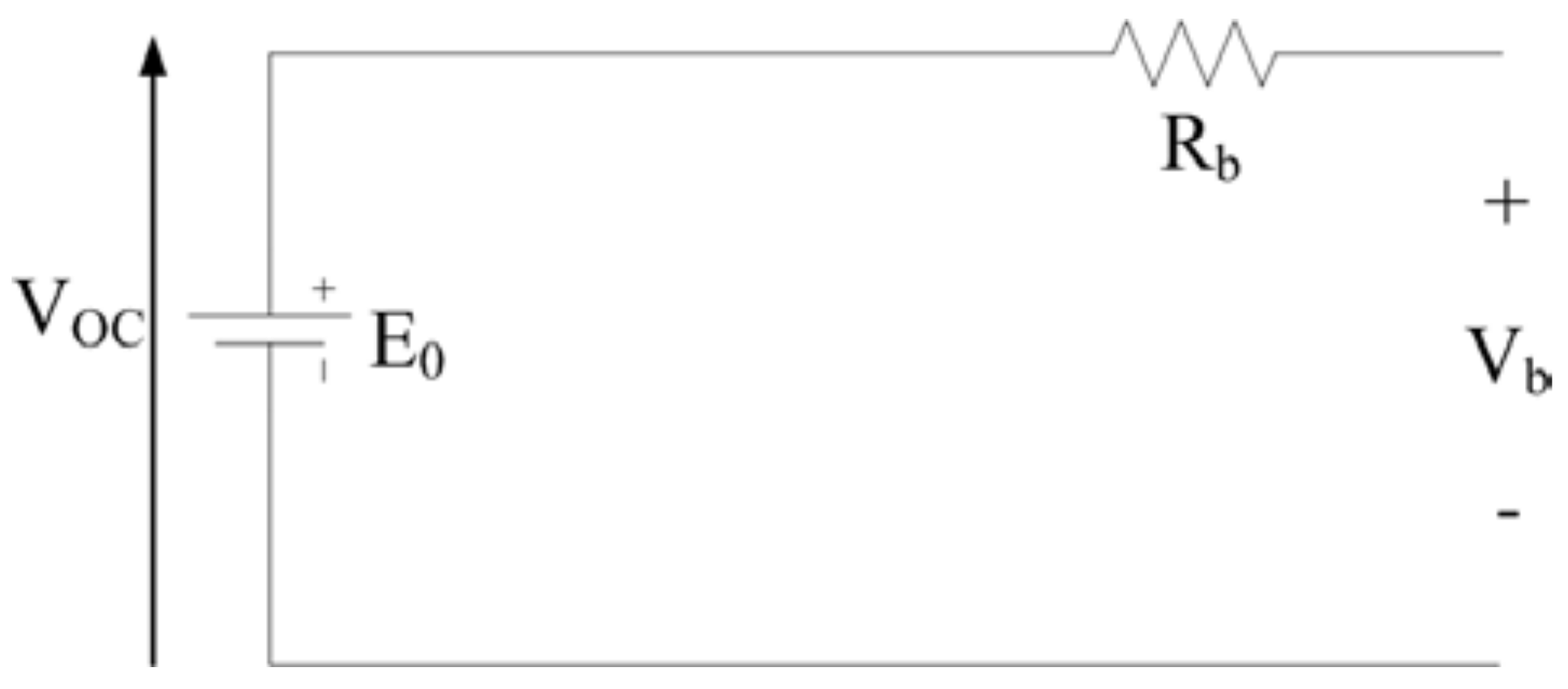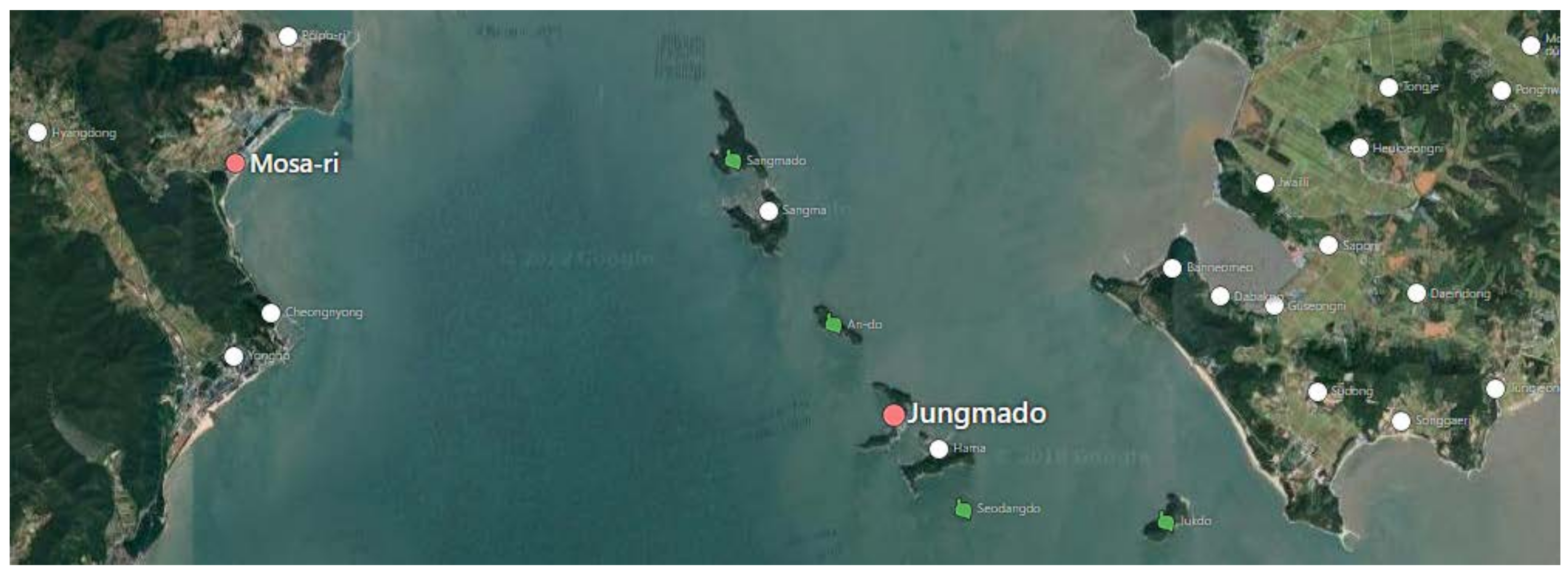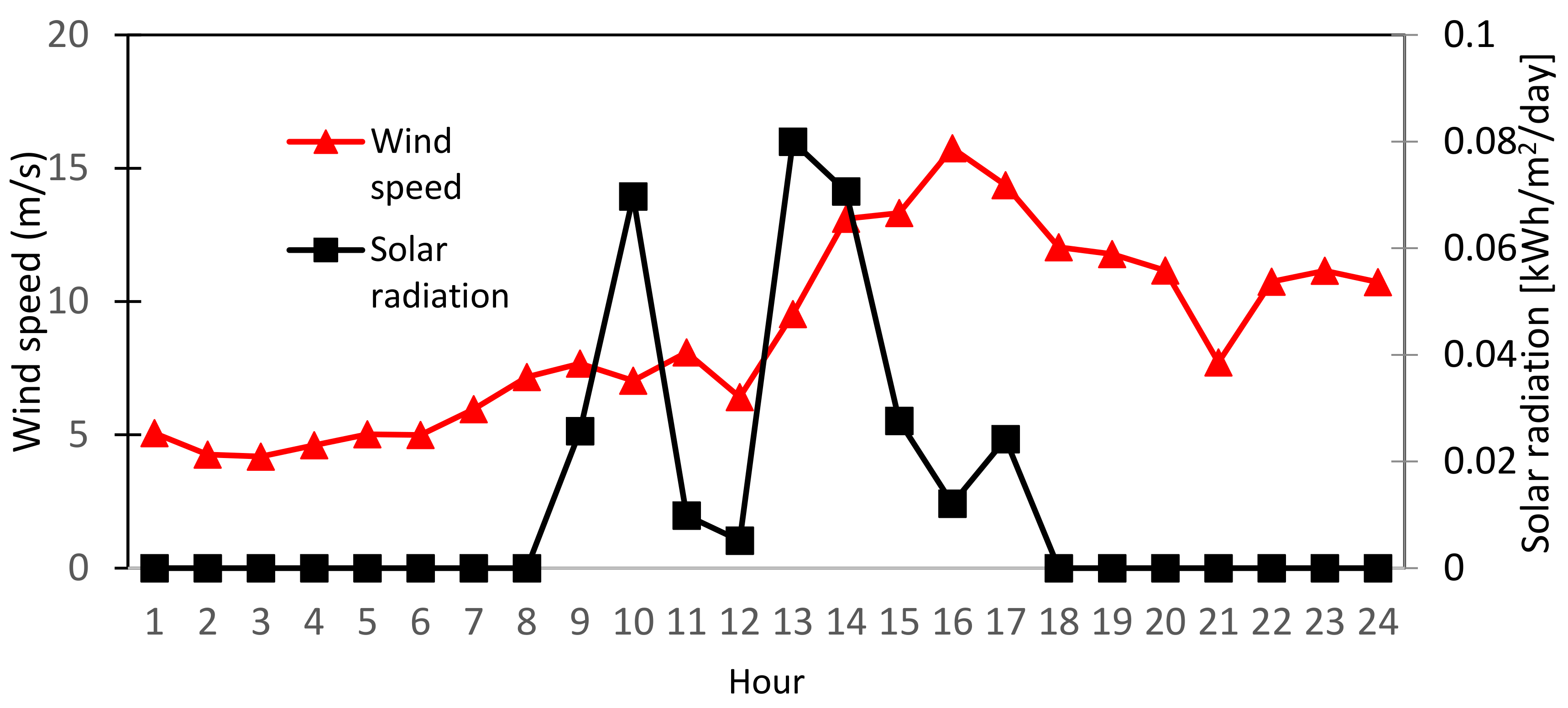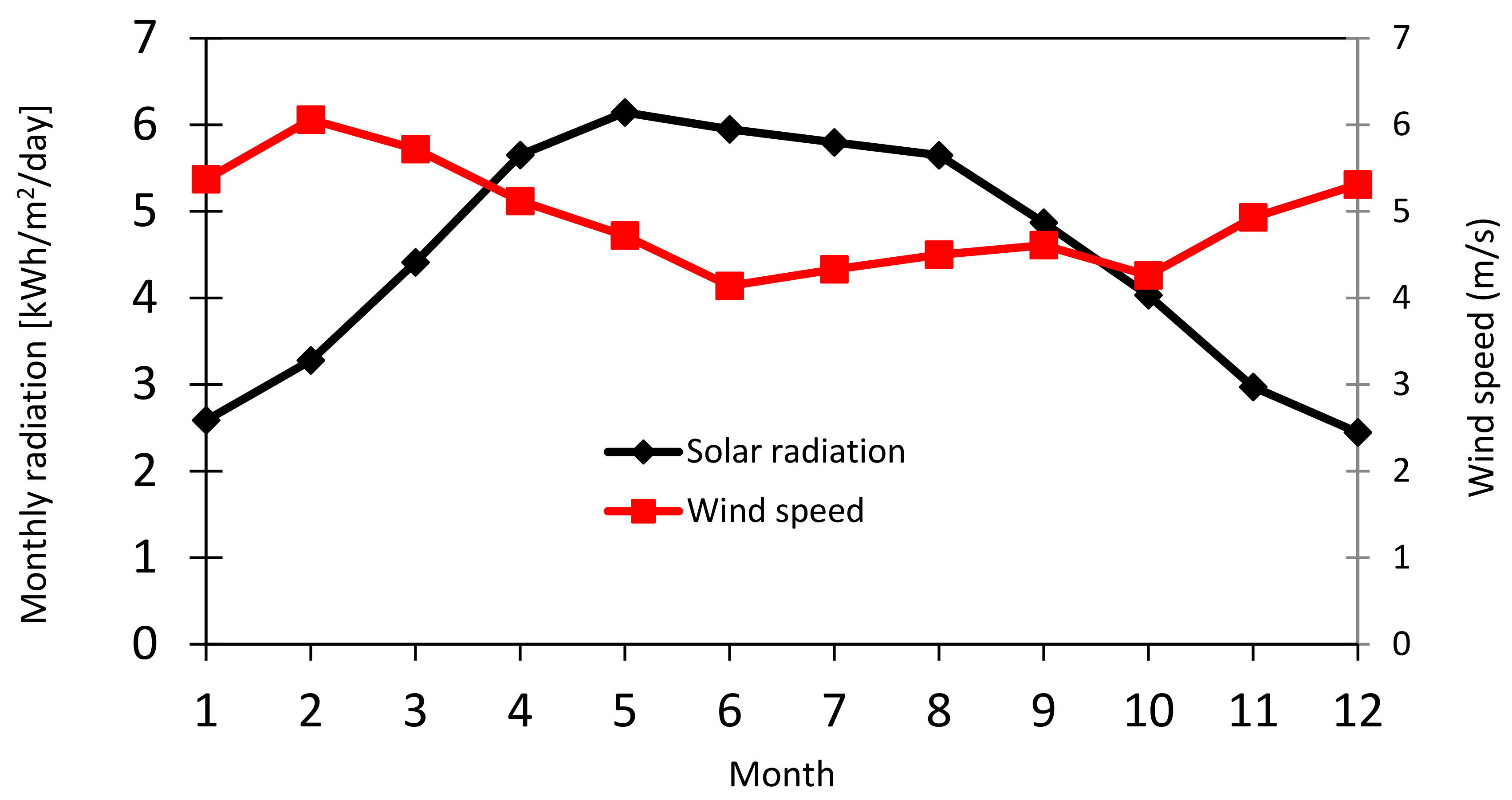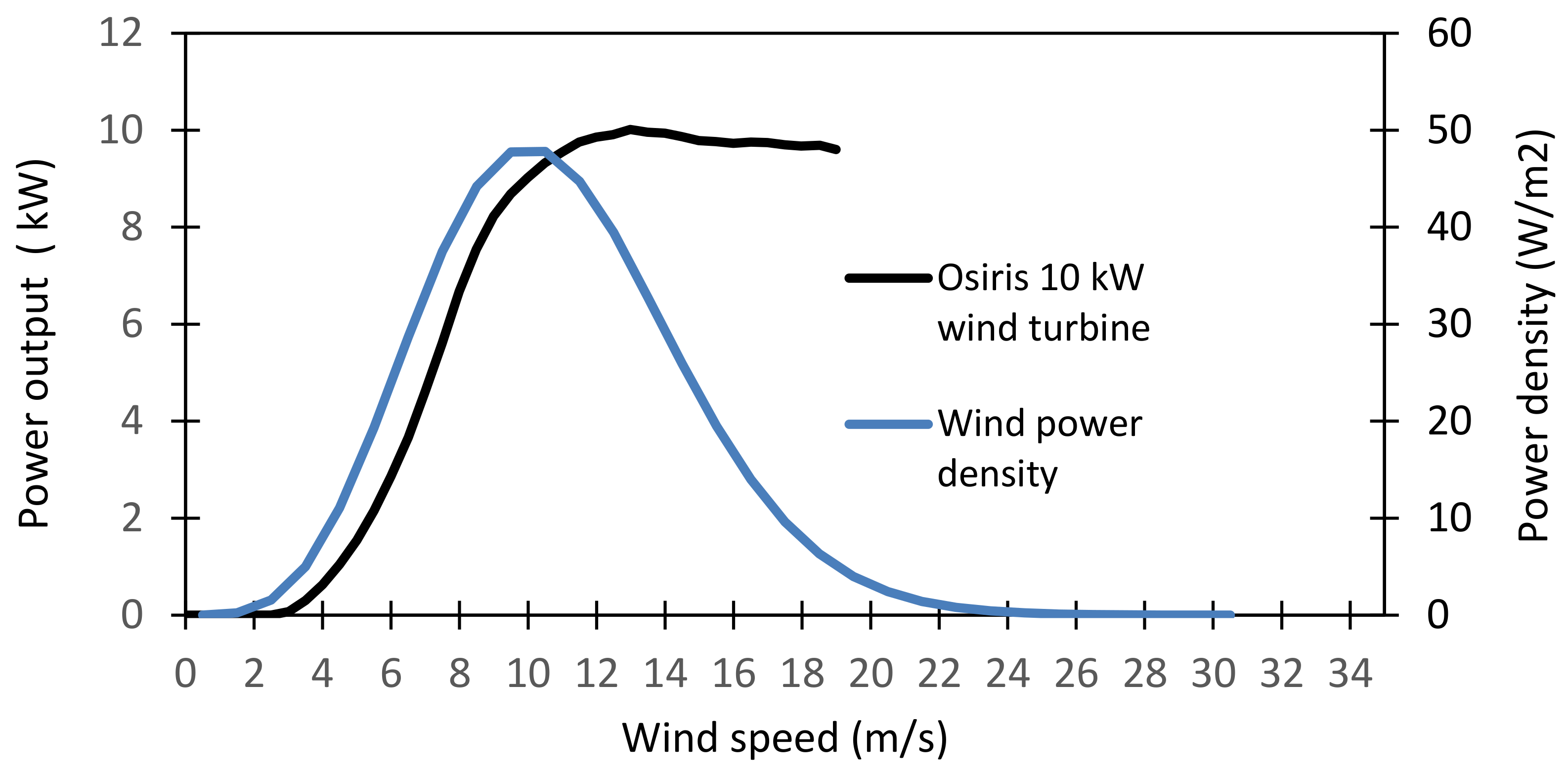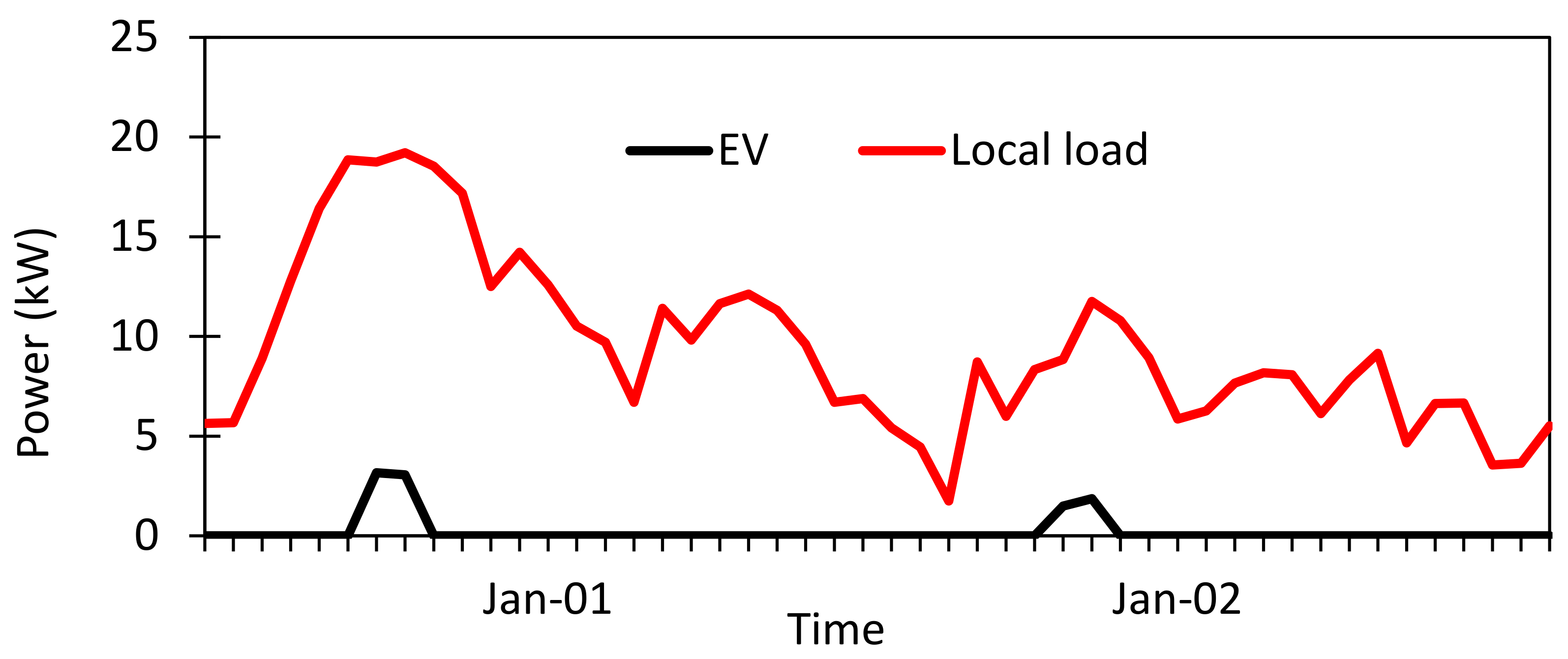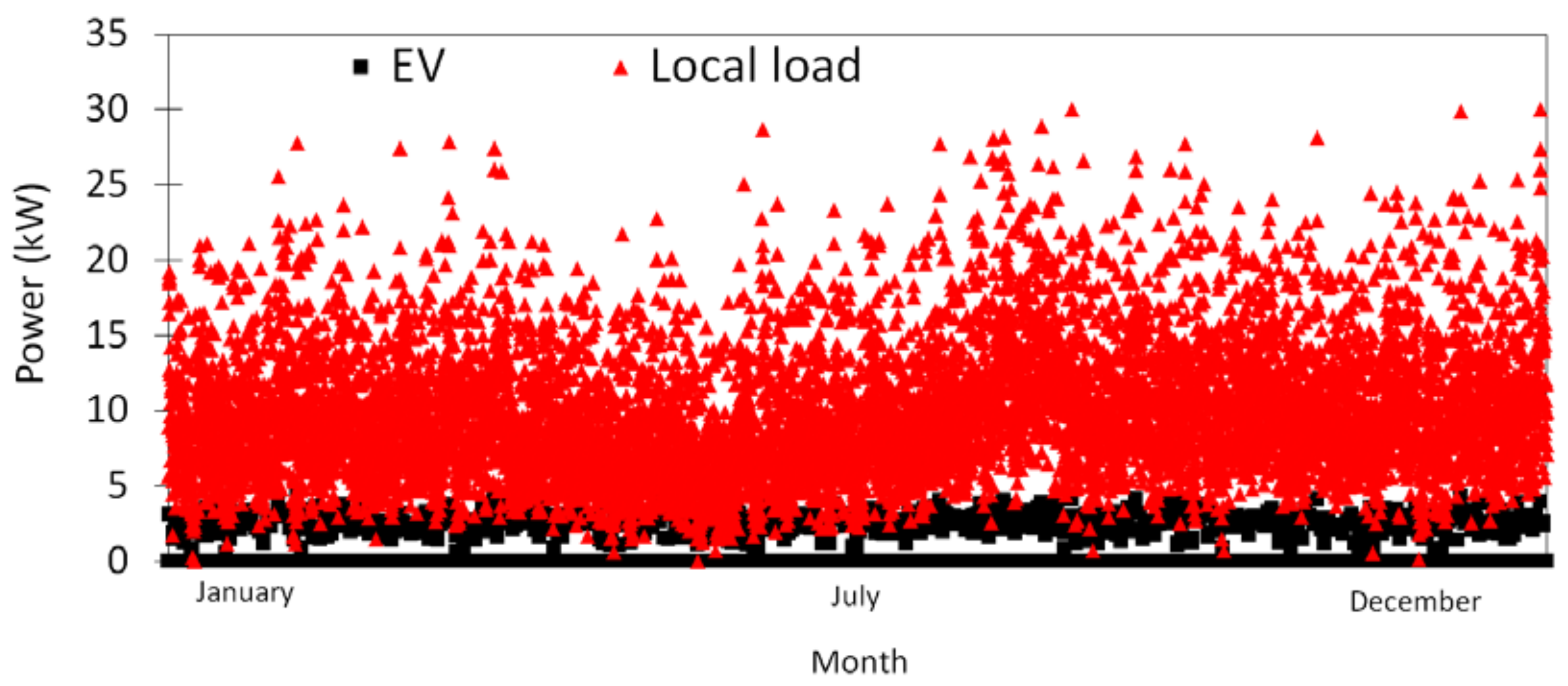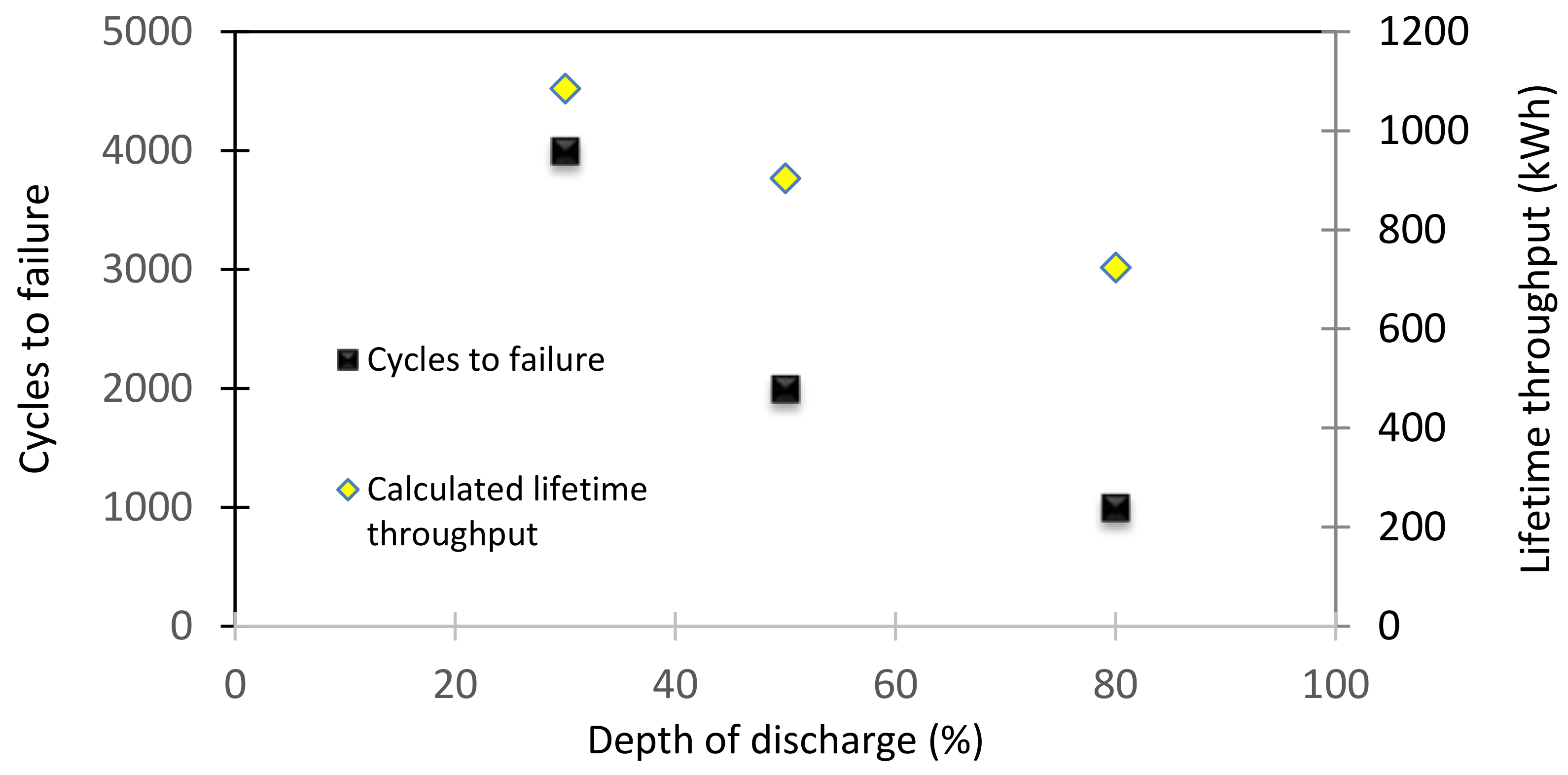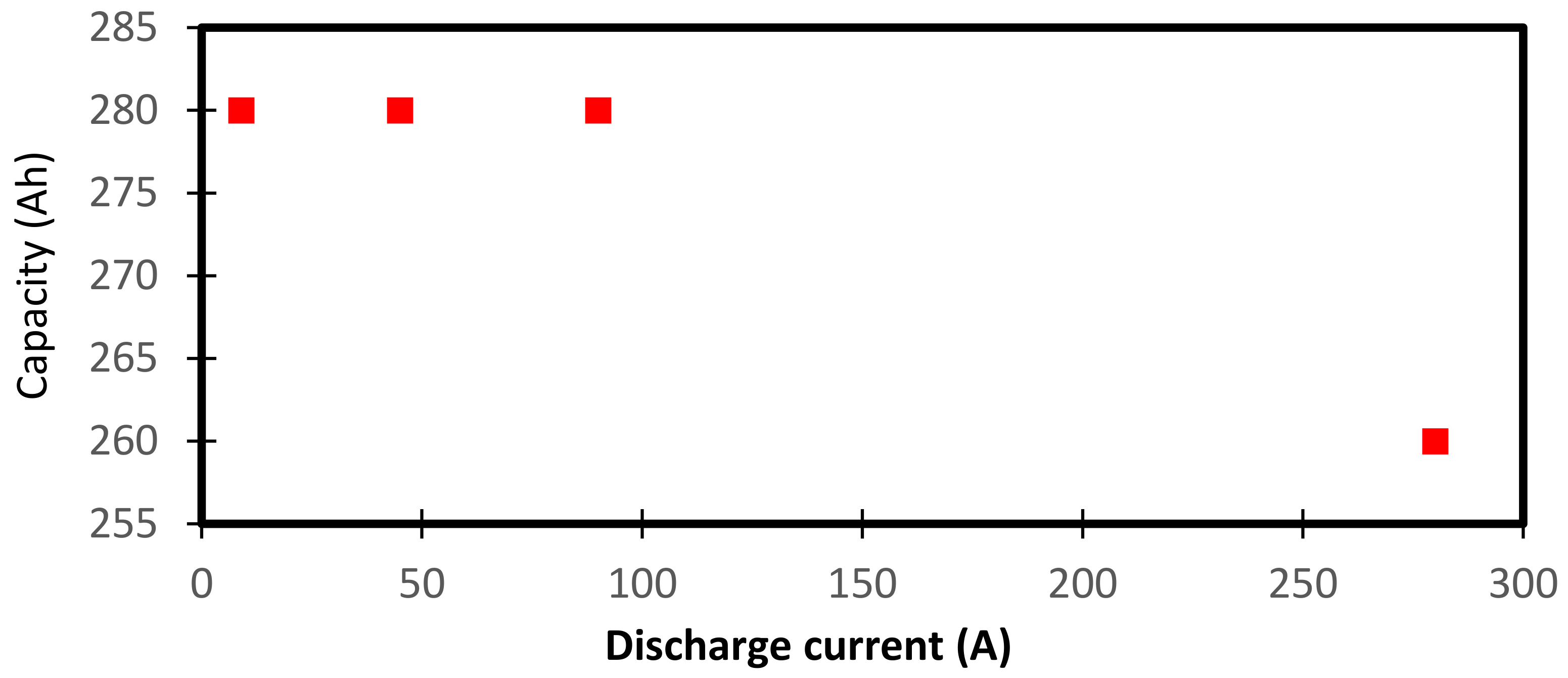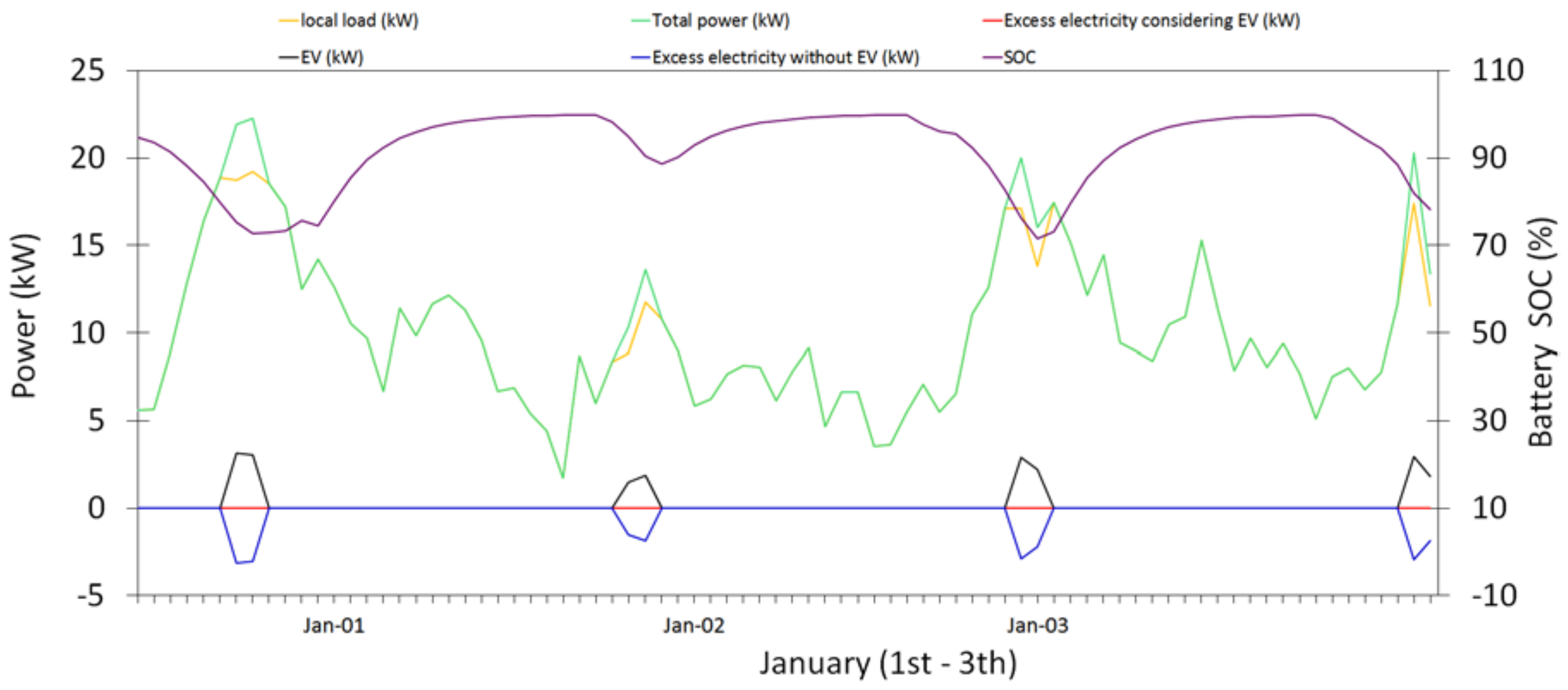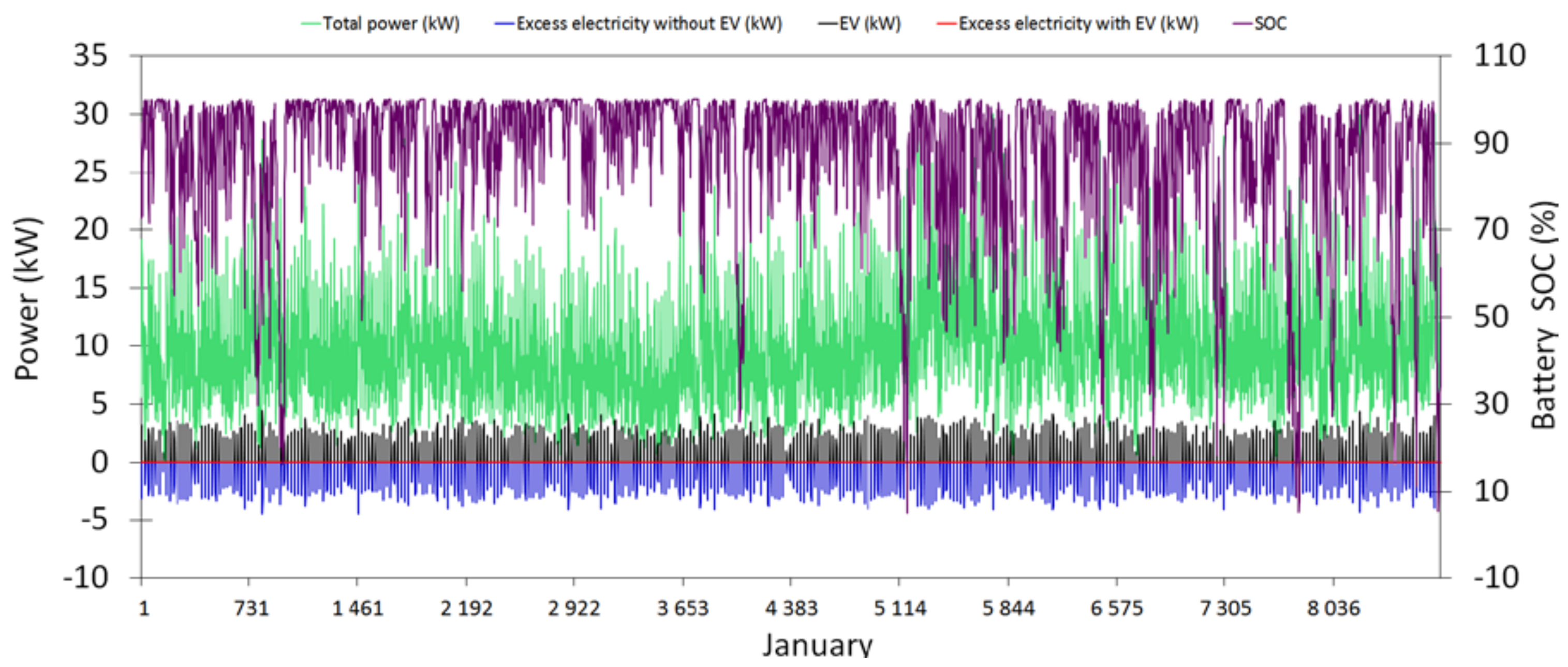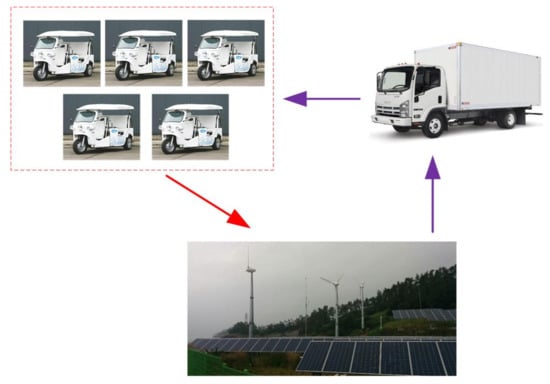1. Introduction
Renewable energy systems used as charging stations for electric vehicles (EVs) have become a major research issue; it is reported that the number of EVs in use is now more than 2 million globally [
1]. One effective way to mitigate either the impacts of EVs on local power or facilitate charging EVs where local power is not available is integrating renewable energy systems with the charging infrastructure [
2]. This will further decrease charging costs as well as emissions [
3]. This concept is crucial and motivates a more detailed study of both cost–benefit justification and feasibility. The major challenge in using either solar or wind as a source of power is that wind or solar power may not be available when electricity is needed [
4]. In fact, the fundamental drawback of renewable energies is fluctuations in power output, especially in photovoltaic (PV) systems [
5]. Hence, it is essential to mitigate fluctuations in renewable energy output power. Integration of a battery energy storage system (ESS) can help to decrease this uncertainty in renewable energy generation, enhancing grid security and reliability. An ESS can also smooth variations in renewable energy power output over a desired time horizon [
6].
The interaction between EVs and renewable energy systems has been widely investigated. The main body of the existing research can be categorized into three groups: cost analysis, performance and efficiency improvement, and emissions.
Studies in the first category are focused on reducing charging costs, electricity charging costs, and operational costs [
7,
8,
9,
10,
11]. Efficiency and performance improvement of renewable energy utilization for EVs have also been studied [
12,
13,
14,
15]. In addition, several groups have examined decreasing emissions when EVs and renewable energy systems are incorporated into the electrical grid [
16,
17,
18].
In this study, we investigated the optimum design of a hybrid renewable energy system on an island based on practical experiments for charging EVs. The objective of this paper is to present a novel strategy for renewable energy utilization for EVs. The proposed hybrid system consists of a PV system, a wind turbine (WT), and a power converter. In addition, we considered lithium-ion batteries to smooth out fluctuations in renewable energy power output. Particularly, this paper aims to extend the methods developed in [
19,
20,
21]. A key limitation of these research works was that the effects of excess electricity on the charging electric vehicles were not considered. Hence, the key point of this study is the efficient use of excess electricity. We also considered a DC charging station for a smart home, where external battery chargers are used for fast charging and depleted batteries are exchanged for charged ones (i.e., battery switching) to power the EVs over a short period. It is worth noting that this standard is highly suitable for small communities where grid electricity is not available. A novel approach is then proposed for obtaining the minimum and maximum number of batteries with the optimum configurations by the solar and wind energy potential. Furthermore, it is shown that the WT plays an important role in the EV charging station; therefore, the effect of WTs on the overall system is also investigated.
The rest of paper is organized as follows.
Section 2 presents the proposed framework for this study. The infrastructure of the proposed charging station is given in
Section 3. The specific details of the system, as well as results, are discussed in
Section 4.
Section 5 concludes the paper.
3. System Modeling and Specification
The proposed renewable energy charging stations consist of WTs, PV systems, an ESS and an inverter, as shown in
Figure 2. Related assumptions and inputs, such as resource data of the proposed site, component parameters, load demand, and sensitivity variables, are given in the following section. In the next section, the optimization and sensitivity results are discussed.
In this study, the Weibull distribution is defined by [
22]
where
k and
c denote the shape factor and scale factor, respectively, of the Weibull distribution
for a certain time
τ. The maximum likelihood method described in [
22] is used to estimate the Weibull distribution parameters
k and
c.
It should be noted that, apart from the energy rating limitation of battery systems, we have losses in the converter and battery current limits that should be taken into account to fully utilize the battery system. Therefore, to use the battery system efficiently in this application, the following limitations must be considered in the structure of the battery system:
SOC: The state of charge of a battery system indicates the available capacity of the battery system as a percentage of the rated capacity. The nominal or available capacity is given by the manufacturer and represents the maximum charge of the battery that can be stored. As neither depletion nor overcharge in the battery is desirable, the SOC of the battery must be kept within proper limits—between 30% and 100%. As such, the charge/discharge time of the battery system will be determined by the limitation in the SOC for the battery, as well as the energy left in the battery.
Depth of discharge (DOD): Cycle life is an important parameter of a battery system that decreases as the DOD increases. Many cell chemistries cannot tolerate deep discharge and may be permanently damaged after complete discharge. Thus, the DOD should be limited to an appropriate range to protect the battery from death and increase the cycle life of the battery. This range can be deduced from the limitation that SOC should not drop below a critical level.
Battery throughput: This corresponds to the amount of energy that can be cycled in the battery system during one year.
Developing a precise model of a battery system considering all specific factors is a complicated task. It has been said that a battery system can be modeled to consist of a resistor (
Rb) in series with an ideal voltage source (
E0). The open circuit voltage (
VOC) gives the voltage across the battery. Meanwhile, the voltage across the resistor
Rb and battery gives the terminal voltage of the battery
Vb, as shown in
Figure 3.
Rb is a function of the SOC of the battery system (i.e., it varies depending on the SOC).
Hence,
Rb can be expressed as
where
Ro is the resistor of the battery in full charge (
Ω) and
k is the capacity coefficient.
S is the SOC factor and varies from 0, fully discharged, to 1, fully charged, given as follows:
where
C10 denotes the 10 h capacity (
Ah) at the reference temperature,
h is the time of discharging (h), and
A is the discharge current (A). From this, we can derive the relationship between the battery capacity and the discharge range as
where
Cap is the battery capacity (
Ah),
I is the discharge current (A), and
F and
y are constant values that can be obtained using the Peukert factor.
In this study, the lifetime throughput (
Qlifetime,i) of the batteries is calculated as
where
fi is the number of cycles to failure,
di is the depth of discharge (%),
qmax is the maximum capacity of the battery (
Ah), and
Vnom is the nominal voltage of the battery (
V). It must be noted that a fraction for “d” must be used in Equation (5).
The proposed method and the logical approach presented in Ref. [
19] was adopted in this study for optimal design of the system. The objective function of the study is considered as
where
CT,
CM, and
CC denote the total cost, the maintenance cost, and capital cost of the system, respectively.
The capital cost as well as the maintenance cost of the system are given as [
19]
where
NW represents the number of wind turbines,
CW is the unit cost of a wind turbine,
NPV is the number of
PV panels,
CPV is the unit cost of
PV panel,
LB is the battery’s life span,
NBT is the number of batteries, and
CBT is the unit cost of a battery,
LInv represents the life span of the inverter,
CInv is the inverter cost, and
CB is the cost of the backup generator.
n is number of years for project lifetime and
j represents the interest rate of the system.
is the maintenance cost of the wind turbine per kWh, and
is the maintenance cost of the PV panel per kWh.
,
, and
denote the maintenance cost of a battery, inverter, and backup generator, respectively.
The total energy generated by the wind turbines and
PV systems at time
t are evaluated as [
19]:
where
, and
denote the power and energy generated by the wind turbines, respectively,
is the study time.
represents the power generated by the PV panels,
is the energy generated by the
PV panels.
4. Results and Discussion
The site is located in the South Sea and is the smallest island of over 3000 islands in South Korea, with a population of 60 across 20 houses. This island is an off-grid system. The island has a latitude of 34.26° and longitude of 126.25.
Figure 4 shows an aerial view of the proposed site in Jung-Ma-Do Island, South Korea, as indicated by ‘A’ in the figure.
The eTuk [
23] is a small electric vehicle developed by the Tuktuk Factory. The characteristics of the eTuk are given in
Table 1.
In addition, the infrastructure charging standard for EVs is given in
Table 2. Home charging includes residential and workplace locations. Semipublic charging stations are those in workplaces, markets, and community facilities. Public charging stations are those in city centers, high streets, and tourist attractions.
Levels 1–3 are linked to the capacity of the charging station. Modes 1–3 are related to the protection types of the charging station. The charging station is designed using an external battery charger for fast charging in mode 4. In reality, depleted batteries are exchanged in mode 4. Mode 4 is well-suited to remote areas and has been considered in our study.
The following assumptions are made according to data from the Tuktuk Factory, as well as the IEC 61851-1 standard. The charging time of the EVs is considered to be fast charging (2 h); energy consumption per EV is 1 kWh/1km; charging time is between 6 a.m. and 7 a.m.; five EVs are considered to be implemented in the site, based on the population of the site (60 with twenty houses); 20% variation in day-to-day charging amount and 20% variation in time steps of the EVs are included. To model the EV as a DC load, a symmetric load profile was constructed, equal to the maximum load that the station could cover over the charging time.
The daily and average monthly wind speed and solar radiation on the island are shown in
Figure 5 and
Figure 6; there was no solar radiation between 18:00 to 8:00 on 1 January. The monthly average wind speed ranged from approximately 4.140 m/s (June) to 6.06 m/s (February). The highest wind speed occurred in February. In addition, the monthly average solar radiation ranged between 2.5 and 6 kWh/m
2/day. The highest value of solar radiation was recorded in May. The annual average monthly wind speed and solar radiation at the site were recorded as 4.92 m/s, and 4.48 kWh/m
2/day, respectively. The annual wind speed was recorded as 4.92 m/s and the maximum wind speed as 29.70 m/s.
As mentioned in
Section 3, the maximum likelihood method [
22] is used to estimate the Weibull distribution parameters
k and
c, as shown in
Figure 7. Additionally, the power curve of the Osiris 10 kW wind turbine is given in
Figure 8. The wind turbine rated speed is 12.50 m/s. The cut-in and cut-out wind speeds are 2.4 m/s and 19 m/s, respectively. The wind power density, measured in watts per square meter, indicates how much energy is available at the site for conversion by a wind turbine.
Figure 9 and
Figure 10 show the load profile of the proposed site. To get an accurate load profile, the variation of the load was considered to be 20% with a time step of 20% per day. In
Figure 10, local loads are presented in red triangles, where load of EVs is presented in black squares. The average energy and power demand was 234 kWh/d and 9.8 kW, respectively. The peak load at the site was estimated as 30.4 kW. The highest energy demand occurred in August. In addition, the load varied throughout the day, for instance from 5 kW to 16 kW on January 1st, with the highest peak of about 16 kW at 8:00.
It is worth noting that the lifetime throughput of the single lithium-ion battery was estimated as 904.4 kWh and calculated according to
Table 7.
Figure 11 shows the lifetime curve of the lithium-ion battery. The lifetime curve reveals the number of cycles to failure versus the depth of the cycles. The lifetime throughput (
Qlifetime,i) can be calculated from the lifetime curve of the battery as
where
fi is the number of cycles to failure,
di is the depth of discharge (%),
qmax is the maximum capacity of the battery (Ah), and
Vnom is the nominal voltage of the battery (v).
Figure 12 shows the capacity curve of the lithium-ion battery. Based on the kinetic battery model and the capacity curve of the batteries, we can calculate the maximum capacity, capacity ratio, and rate constant of the capacity, as reported in
Table 6.
Based on the above meteorological data, component costs and load profile, several case studies were carried out to acquire the optimum configuration of the proposed hybrid renewable energy system.
Table 8 and
Table 9 show the optimum design of the proposed system according to a sensitivity analysis conducted on WTs and the ESS, respectively. The optimal system considering 368 batteries with 30 kW of inverter power had a total power of 130 kW with a 24% WT fraction and a 76% PV fraction. This combination resulted in the lowest net present cost (NPC) of
$1,182,040. It is worth noting that the optimal case without considering EVs is 30 kW of WT, 130 kW of PV system, and 35 kW of inverter with 276 batteries, with a total NPC of
$1,159,326. According to wind speed and solar radiation data at the site, capacity factors for the WT (25%) and PV systems (16%) were estimated. The WT capacity factor of 25% demonstrates the ratio of WT actual power output over 8760 h (one year of operation), to potential output power if operated at full capacity during the year.
Figure 13 shows the optimum combination of PV and wind systems with increasing battery numbers, to obtain the minimum and maximum number of lithium-ion batteries.
We can see from
Figure 13 that the total power can be dramatically reduced for systems with a large number of batteries. However, further decreases in wind turbines and PV panels were not observed (70 kW of PV system and 10 kW of WT system) as the number of batteries increased from 920 to 1196, as the ESS is not a power-generating component, and the minimum necessary renewable energy system (i.e., PV and wind system) should be implemented to match the load. Hence, the total number of batteries should range between 276 and 920. Explicitly, the minimum number of batteries was considered to be 92. However, this cannot be economically matched with the load. On the other hand, having more than 920 batteries had no effect on the renewable hybrid system combination because the load was already matched and no additional changes were observed in the system configurations. Therefore, the ESS must range between 276 and 920.
The relationship between SOC and excess electricity thus far is detailed in
Figure 14 and
Figure 15. The graph indicates that the ESS absorbs the energy once the PV and wind energy output power exceeds the load demand, and discharges the energy as the load exceeds the output power. As can be seen, once the load demand is satisfied, excess electricity was used to charge the EVs. The SOC of the batteries illustrates the amount of energy stored in the ESS as a percentage of the capacity. In the case of sufficient excess electricity to fully charge the battery, the energy will be used for charging EV batteries. It is necessary to point out that the operating reserve is considered to be 10% of the load, 25% of PV output, and 50% of WT output in this study. In addition, the maximum annual capacity shortage was assumed to be 0%. However, we observed depletion of the ESS, which occasionally occurred during the one-year simulation period. This issue is termed the unmet electricity load, 42.5 kWh (capacity shortage of 0.1%) for the system. In summary, excess electricity in the renewable energy system is used economically to charge the EV batteries. In this regard, the excess electricity (red line) of the entire system considering the EVs is zero.
